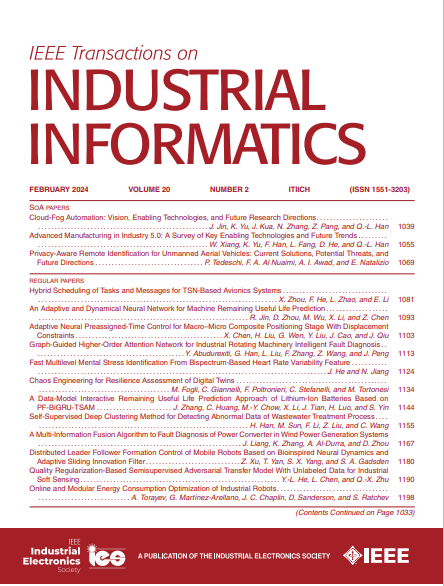基于混合知识的机床刀具数字孪生
IF 9.9
1区 计算机科学
Q1 AUTOMATION & CONTROL SYSTEMS
引用次数: 0
摘要
由于计算机数控机床系统在制造过程中的基本执行作用,因此有必要进行实时、智能、自适应的计算机数控机床系统。从信息物理系统演变而来的数字孪生(DT)为这一需求提供了解决方案。然而,大多数商业DT软件侧重于仿真,缺乏制造过程的在线诊断和预测。同时,传统的研究主要集中在机床部件的建模,而不是刀具和工件的建模,导致与产品质量的相关性较差。此外,很少考虑刀具磨损补偿以提高质量。为了解决这些问题,本文提出了一种基于知识的机床刀具混合DT。首先对一种新型机床的DT结构进行了演示和说明。然后,讨论了如何通过加工过程、生成信号和实时测量信号构建数字阴影,整合物理和数据领域知识进行诊断和刀具磨损预测,以及补偿刀具磨损进行加工过程在线优化的实现方法。最后通过实例验证了该算法的阴影保真度、预测精度和补偿效果。结果表明,该方法能够在实际加工过程中实现,有效地提高了工件质量。本文章由计算机程序翻译,如有差异,请以英文原文为准。
Hybrid Knowledge-Based Digital Twin for Cutters of Machine Tools
It is necessary to conduct a real-time, intelligent, and self-adaptive computer numerical control machine tool system due to its basic executor role in the manufacturing process. The digital twin (DT), evolved from the cyber-physical system, provides a solution to this demand. However, most commercial DT software focuses on simulation, lacking online diagnosis and prediction of the manufacturing process. Meanwhile, conventional research concentrates on component modeling of machine tools rather than cutters and workpieces, leading to poor correlation to product quality. Furthermore, tool wear compensation is seldom considered for quality improvement. To address these issues, this article proposes a hybrid knowledge-based DT for cutters of machine tools. A novel DT architecture of a machine tool is demonstrated and explained first. Then, the implementation methods for how to construct digital shadow via the machining process, generated and real-time measured signals, to integrate knowledge from physics and data domain for diagnosis and tool wear prediction, and to compensate for the tool wear for machining process online optimization are discussed. Finally, a case study shows the shadow fidelity, prediction accuracy, and compensation effectiveness. Results show that the proposed method can be implemented in the practical machining process and improve the workpiece quality efficiently.
求助全文
通过发布文献求助,成功后即可免费获取论文全文。
去求助
来源期刊

IEEE Transactions on Industrial Informatics
工程技术-工程:工业
CiteScore
24.10
自引率
8.90%
发文量
1202
审稿时长
5.1 months
期刊介绍:
The IEEE Transactions on Industrial Informatics is a multidisciplinary journal dedicated to publishing technical papers that connect theory with practical applications of informatics in industrial settings. It focuses on the utilization of information in intelligent, distributed, and agile industrial automation and control systems. The scope includes topics such as knowledge-based and AI-enhanced automation, intelligent computer control systems, flexible and collaborative manufacturing, industrial informatics in software-defined vehicles and robotics, computer vision, industrial cyber-physical and industrial IoT systems, real-time and networked embedded systems, security in industrial processes, industrial communications, systems interoperability, and human-machine interaction.
 求助内容:
求助内容: 应助结果提醒方式:
应助结果提醒方式:


